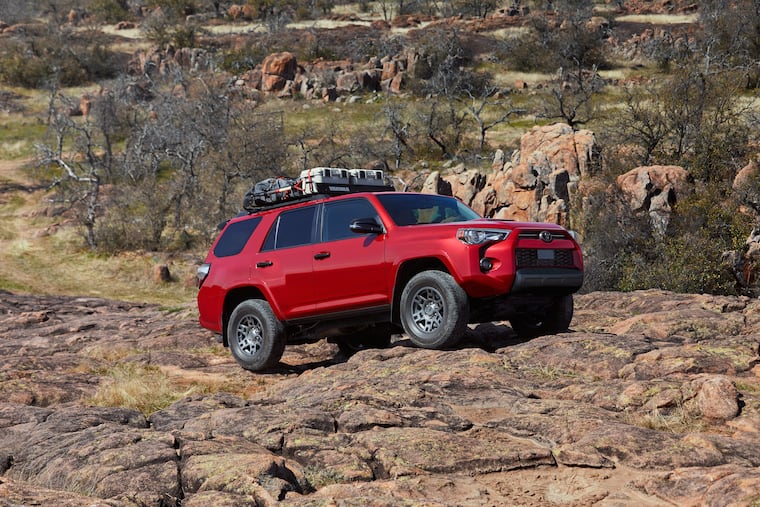SUV test, part 2: 4Runner takes us on a rugged trip back in time
The best comparison for the 4Runner? A fire truck. Hard, rubbery, rhinoceros hide leather seats. High driving position, perfect for climbing to the next fire tower. Huge tires for scaling rocks.

2020 Volkswagen Atlas Cross Sport 4Motion SEL Premium V-6 R-Line vs. 2020 Toyota 4Runner 4x4 Nightshade V6: A 50-grand trail competition
This week: Toyota 4Runner
Price: $52,070. Automatic running boards, $1,500; special color, $425. (Wonders how much a Very Special Color would be.) More below.
Marketer’s pitch: “When your adventures require more.”
Conventional wisdom: Motor Trend called the 2017 “utilitarian and rugged in all the right ways.”
Reality: A very different kind of adventure.
Catching up: Last week, we drove the Volkswagen Atlas Cross Sport, which takes the SUV and turns it into a delightful sports car, but gets a 1 out of 5 reliability rating.
Big and traditional: The 4Runner goes a completely different route — rough, tough, and ready for anything.
But break new ground it does not. The 4Runner follows big brother Sequoia’s mantra: If it ain’t broke, don’t fix it. While it’s gotten many updates over the years, this traditional body-on-frame SUV was last revamped for the 2010 model year, and it looks not unlike a truck from 30 years ago.
On the road: Surprisingly, it doesn’t drive like a truck from 30 years ago. It’s not fun, but the handling is steady and the big vehicle doesn’t bounce and sway over uneven roads like many more “advanced” and expensive units (I’m glaring at you, Mercedes and BMW).
I never did get a chance to take the 4Runner off-road, though.
Up to speed: The 4.0-liter V-6 creates 270 horsepower and 278 pound-feet of torque, and moves the lumbering giant to 60 mph in 8.0 seconds, according to a Motor Trend test of the 2017 with the same drivetrain.
In addition, drivers must prepare to put a whole lot of force into motivating the 4Runner. The accelerator pedal requires a long throw from start to full throttle, and I felt like I needed to adjust the Driver’s Seat to do so. Pound feet indeed.
Shifty: A 5-speed automatic — no, that’s a not a typo — shows how far back in time the 4Runner exists.
Toyota follows its usual pattern with the automatic transmission; there’s a spot for shifting, but it’s just there for drivers to pick a gear, maybe for slowing descent on a hill. Highly beneficial, because the brake pedal requires almost as much pressure as the accelerator.
Driver’s Seat: All this hard work to get the vehicle started and stopped, coupled with the firm Driver’s Seat, means the 4Runner quickly becomes a painful adventure. Even the Lovely Mrs. Passenger Seat — not nearly so delicate as her mate — dubbed the seat hard.
Toward the end of the test, I realized the best comparison for the 4Runner: a fire truck. The hard, rubbery, rhinoceros hide leather seats. The high driving position, perfect for climbing to the next fire tower for a lookout. The big tires for scaling boulders.
I rode in and on a few fire trucks as a youngster — small town block parties, yay — but have never driven a fire truck. In fact, I’d love to be a firefighter if I weren’t afraid of heights. Or fire. Or heat. Or sharing living space with colleagues. Or chili. Still, I imagine the handling and feel are like the 4Runner.
Friends and stuff: At least everyone suffers equally. The middle row‘s foot room and headroom are surprisingly scant for the size of the vehicle. (Most of the 4Runner’s tall profile goes toward ground clearance.)
Third-row victims face the worst accommodations of all, naturally — not just among SUVs, but perhaps in the entire universe of vehicles, including maybe covered wagons, school buses, and fold-up trailers. The jump seat bottoms slide out after the backs are pulled up — a struggle on all counts — so it’s obvious they’re going to be thin and cardboardy. But occupants may be more focused on the legroom (nonexistent) and the headroom (Excedrin should come standard).
The seats added $1,365 to the sticker price, but now the second-row seats slide.
To help soothe the sting, though, the console conveniently holds four bottles of wine.
Cargo space is nil behind the third row. The breakdown runs 88.8/46.3/9.0 cubic feet. (An MX-5 has about 5 cubic feet of trunk space.)
Play some tunes: The radio features big dials for volume and tuning, plus a touchscreen, pretty standard Toyota fare. Getting from place to place in the system is simple.
Sound quality from the premium audio, though, is pitiful. It’s better than the aging Sturgis Family Sienna, but not by much, maybe a C or so.
Keeping warm and cool: Temperature is controlled by dials designed for Big Manly Paws, while large buttons control the rest. Seat heating and ventilation feature a dial that requires a different set of hands all together. Adopt a monkey?
Fuel economy: I averaged 17 mpg in the usual Mr. Driver’s Seat loop of socially distanced testing. Feed the 4Runner anything; probably vintage gasoline works best.
Where it’s built: Tahara, Japan
How it’s built: Consumer Reports predicts the 4Runner’s reliability to be a 5 out of 5.
In the end: Despite much to poke fun at, the 4Runner’s rugged demeanor does make it a pleasant enough ride. I guess order a Crutchfield stereo on Day 2. And while the Cross Sport was a delight to drive, the reliability data make it a nonstarter, probably literally.
Still, if I really needed something rugged, I’d opt for a Jeep Wrangler. And the fun is built right in.